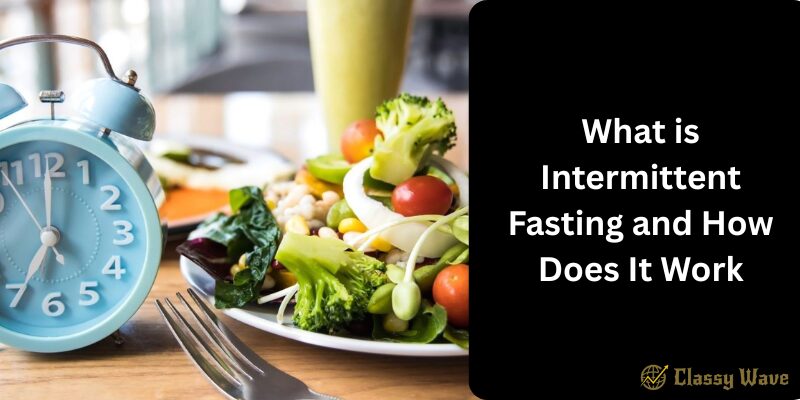What is Intermittent Fasting and How Does It Work | Classy Wave
Have you ever skipped breakfast and noticed you weren’t as hungry as you thought you’d be? Or maybe you’ve heard about people fasting to lose weight and boost their health? That’s what intermittent fasting is all about — giving your body a break from eating so it can focus on more than just digestion.
Let’s explore what intermittent fasting really means, how it works, and why it’s become such a popular lifestyle trend for health-conscious people.
What Is Intermittent Fasting?
Intermittent fasting (IF) isn’t a diet — it’s an eating pattern. It doesn’t tell you what to eat but rather when to eat. The concept revolves around alternating periods of eating and fasting.
For example, you might eat all your meals within an 8-hour window and fast for the remaining 16 hours. This method allows your body to rest from constant food intake and focus on repairing itself.
How Does Intermittent Fasting Work?
When you eat, your body uses glucose (from carbohydrates) for energy. But when you fast, your body runs out of glucose and begins to use stored fat instead. This process is called metabolic switching, and it’s the secret behind fasting’s fat-burning benefits.
During fasting:
- Insulin levels drop, helping your body burn stored fat.
- Growth hormone increases, promoting muscle maintenance and fat loss.
- Cell repair processes (like autophagy) become more active, helping your body remove damaged cells.
Popular Intermittent Fasting Methods
There’s no one-size-fits-all fasting plan. Here are the most common ones:
1. The 16/8 Method
This is the most popular type — fast for 16 hours and eat within an 8-hour window (for example, from 12 PM to 8 PM).
2. The 5:2 Diet
Eat normally for five days a week and restrict calories to 500–600 for the remaining two days.
3. Eat-Stop-Eat
Fast for a full 24 hours once or twice a week (for example, from dinner to dinner).
4. Alternate-Day Fasting
You alternate between fasting days and normal eating days.
5. The Warrior Diet
Eat small amounts of raw fruits and vegetables during the day and one large meal at night within a 4-hour window.
Benefits of Intermittent Fasting
Intermittent fasting has several scientifically supported benefits beyond weight loss.
1. Weight Loss and Fat Reduction
Fasting naturally reduces calorie intake and boosts metabolism. It helps your body use fat as its main energy source, leading to steady weight loss.
2. Improved Insulin Sensitivity
IF helps lower blood sugar levels and reduces the risk of type 2 diabetes.
3. Heart Health
Studies show fasting can reduce LDL (bad cholesterol), triglycerides, and inflammation — all of which benefit heart health.
4. Cellular Repair
Fasting activates autophagy, a natural process where the body cleans out damaged cells and regenerates new ones.
5. Brain Function
Intermittent fasting boosts brain-derived neurotrophic factor (BDNF), supporting memory and learning, and may lower the risk of Alzheimer’s.
6. Longevity
Animal studies suggest fasting can extend lifespan and delay age-related diseases.
What You Can Drink During Fasting
You can’t eat food, but you can stay hydrated. Here’s what’s allowed:
- Water (plain or sparkling)
- Black coffee
- Green tea or herbal teas
- Apple cider vinegar (diluted)
Avoid anything with sugar or calories, as that can break your fast.
Common Mistakes to Avoid
Many beginners make small mistakes that affect results. Here’s what to watch out for:
- Overeating during eating windows
- Breaking fast with junk food
- Not drinking enough water
- Ignoring sleep and stress management
- Expecting results overnight
Is Intermittent Fasting Safe for Everyone?
Not everyone should try intermittent fasting. People with diabetes, eating disorders, or pregnant women should avoid fasting unless approved by a doctor. Always listen to your body — if fasting makes you dizzy, weak, or anxious, it might not be right for you.
Tips to Start Intermittent Fasting
- Start slow — begin with 12-hour fasts and gradually increase.
- Stay hydrated — drink water often.
- Eat whole, nutritious foods during eating windows.
- Avoid processed and sugary foods.
- Get enough sleep and manage stress.
- Be consistent — results take time.
Intermittent Fasting Myths
There are several myths floating around about fasting:
- Myth 1: Fasting slows your metabolism.
- Truth: Short-term fasting actually boosts metabolism slightly.
- Myth 2: You’ll lose muscle.
- Truth: With enough protein and proper refeeding, you’ll maintain muscle.
- Myth 3: Fasting causes fatigue.
- Truth: Once your body adapts, energy levels often improve.
What to Eat After Fasting
When it’s time to break your fast, avoid overeating. Start with light and nutrient-rich foods:
- Smoothies or fruits
- Lean protein (chicken, fish, tofu)
- Vegetables
- Whole grains
- Healthy fats (avocado, olive oil)
Long-Term Sustainability
Intermittent fasting is not a quick fix — it’s a lifestyle. Many people combine it with healthy diets like the Mediterranean or Keto diet for better long-term results.
Conclusion
Intermittent fasting is more than a trend — it’s a science-backed approach to improving health, losing weight, and boosting energy. Whether you’re trying to shed pounds or simply give your digestive system a rest, intermittent fasting can be a powerful tool when done right.
Listen to your body, stay consistent, and watch how your energy and focus improve with time.







